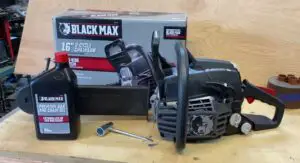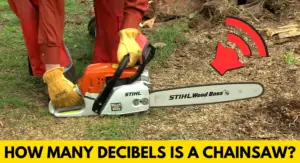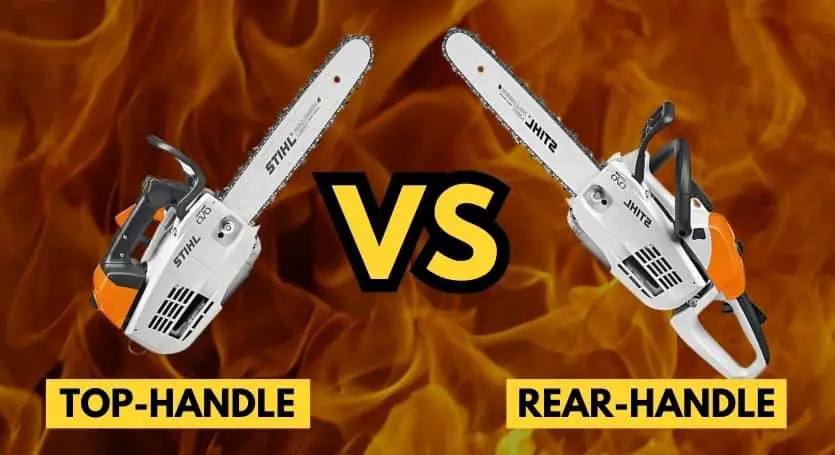
Top-handle VS rear-handle chainsaw – which one is better?
Rear-handle chainsaws are cheaper, easy to use, and offer great stability on the ground. Top-handle chainsaws, on the other hand, are designed for working in trees by professional arborists. They’re lightweight, compact, and highly maneuverable. But these saws are way more expensive.
Btw, I’m Samuel Anali and I have over 20+ years of experience playing with different types of chainsaws. 😎
And in this article, I’m going to compare top-handle and rear-handle chainsaws from various aspects (e.g. price, weight, size, safety, design, bar length, etc.) to help you decide which one’s better for you.
So, let’s jump right in!
Table of Contents
ToggleDifferences Between Top-Handle and Rear-Handle Chainsaws
Here’re the differences between a top-handle and a rear-handle chainsaw: 👇
| Features | Top-Handle Chainsaw | Rear-Handle Chainsaw |
|---|---|---|
| Handle Placement | Positioned on top of the chainsaw. | Positioned at the rear of the chainsaw. |
| Intended Use | Top-handle chainsaws are designed for working in trees. | Rear-handle chainsaws are designed for general cutting tasks on the ground, like felling trees, bucking, and cutting logs. |
| Weight | Top-handle chainsaws are around 16% lighter than rear-handle chainsaws. | Rear-handle chainsaws are typically heavier in weight. |
| Price | Depending on the specs, brand, and model, top-handle chainsaws are 15-30% more expensive than rear-handle chainsaws. | Rear-handle chainsaws are usually cheaper than their top-handle counterparts. |
| Guide Bar Length | Top-handle chainsaws usually come with a 12-16 inches bar. | Rear-handle chainsaws usually come with a 16-24 inches bar. But depending on the power, you can put a bar as long as 72 inches on your rear-handle chainsaw. |
| Size | Top-handle chainsaws are very compact and have incredible balance. | Rear-handle chainsaws are typically larger and more powerful. |
| Operator Experience | Top-handle chainsaws are meant to be used by trained arborists only. | Rear-handle chainsaws are more beginner-friendly, requiring no previous experience to use them. They’re suitable for both novice and professional users. |
Are Top-Handle Chainsaws More Expensive?
On average, top-handle chainsaws are 15-30% more expensive than their rear-handle counterparts (depending on the brand, model, and specs).
The chart below shows the price difference between top-handle and rear-handle chainsaws: 👇
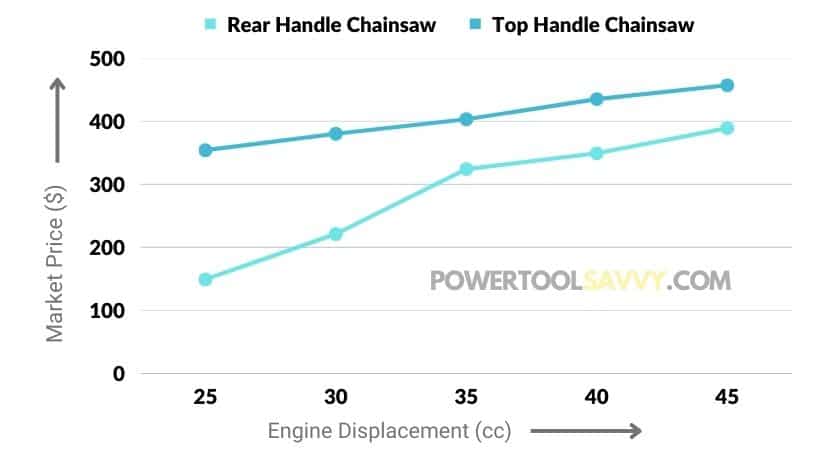
For example, while you can get a branded 25cc rear-handle chainsaw for around $150, a top-handle model of the same power might cost you anywhere between $300 – $350.
Don’t believe me??
Here’s the proof: 👇
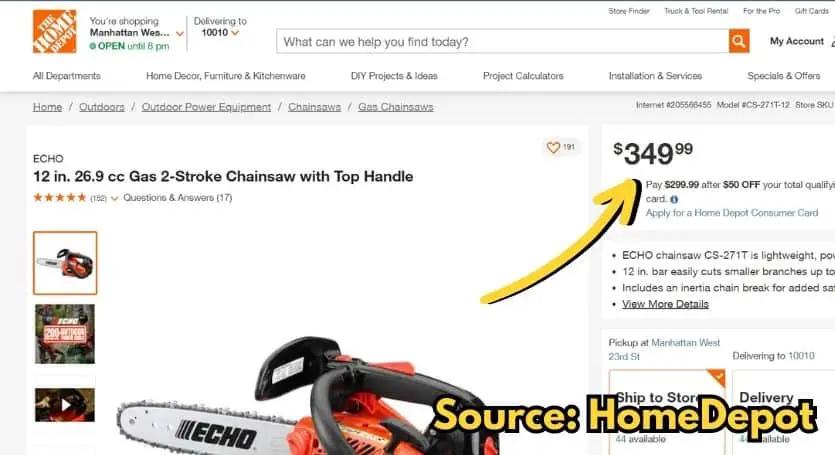
(I know there’re a few brands like NEO-TEC that offer budget-friendly top-handle saws under $200. But to be honest, I’ve NO idea how reliable they are!)
Top Handle VS Rear Handle Chainsaw - Design Comparison
As the name suggests, a top-handle saw has its handle on the top, while a traditional rear-handle saw has its handle at the rear.
Have a look: 👇
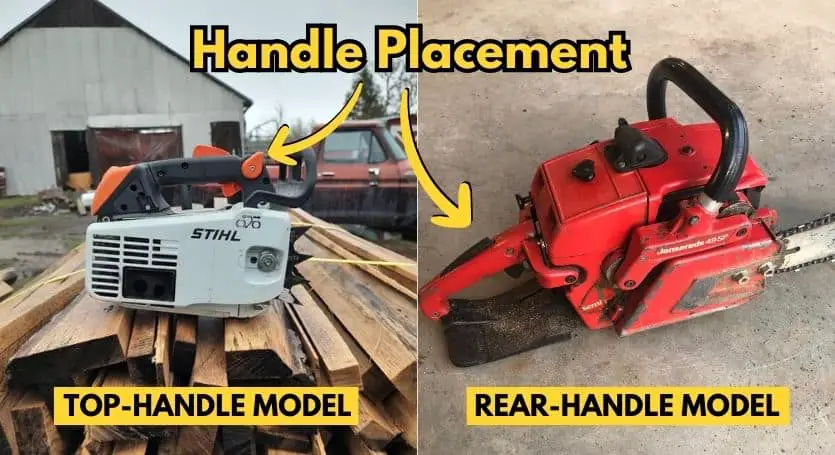
(I’m sure if I put two of these saws next to each other, even a little kid 🧒 could easily tell which one’s the top-handle and which one’s the rear-handle!)
The top-mounted handle provides a better grip when you’re high up in the tree, allowing for single-handed operation. 💪
But the traditional rear-handle design is more ergonomic and gives you a better control when felling trees, bucking, or cutting logs.
However, there’s one thing in common!
Both types of saws have got a second handle for better grip!
In rear-handle models, it’s usually located on top of the powerhead, while in top-handle models, it’s on the left side.
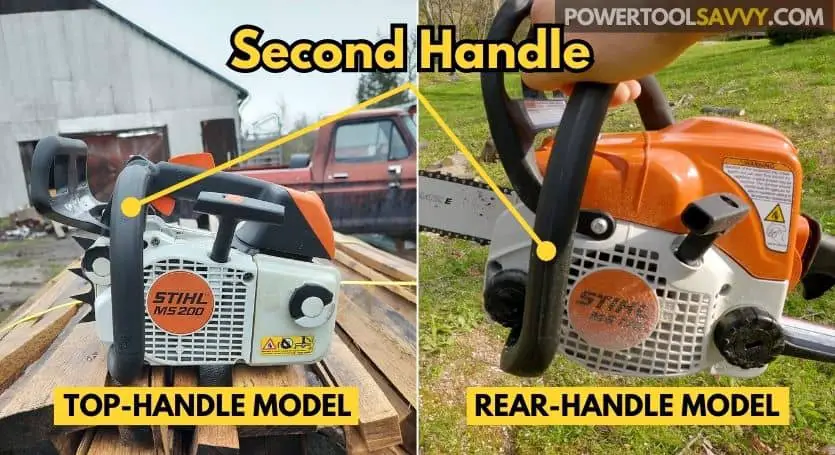
Top Handle VS Rear Handle Chainsaw - Weight Comparison
It’s no surprise!!
Top-handle chainsaws are around 16% lighter than their rear-handle cousins. For example, while a 35cc rear-handle chainsaw weighs around 9.4 lbs (avg), a top-handle model of the same size weighs only 7.9 lbs (avg).
When you’re up in the tree, the LIGHTER the chainsaw, the BETTER! 🐸
It reduces the strain on your arms and back, and makes it more comfortable when working at a shoulder height.
The chart below shows the weight difference between top-handle and rear-handle chainsaws: 👇
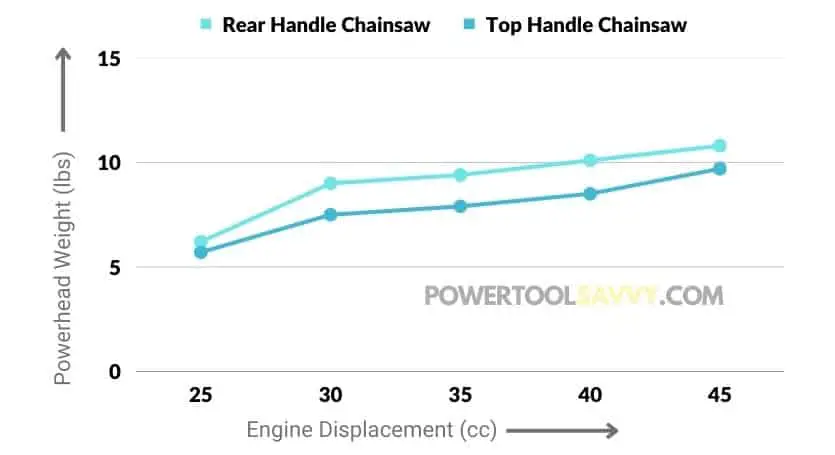
Note: I’ve only compared the powerhead weights – without the bar and chain!
The weight difference may not seem like much, but when you’re hanging off a tree, every ounce counts.
(I’ve worked as a professional arborist for 7+ years! So, you can trust me on this one!)
Clearly, top-handle chainsaws are the WINNER when it comes to weight! 🎉
Top Handle VS Rear Handle Chainsaw - Maximum Bar Length
Traditional rear-handle chainsaws are commonly available with bar lengths between 16 to 24 inches. And depending on the power rating of your saw, you can put a bar as long as 72″ long!
Not exaggerating at all!
Top-handle chainsaws, on the other hand, are available with a maximum bar length of up to 16 inches.
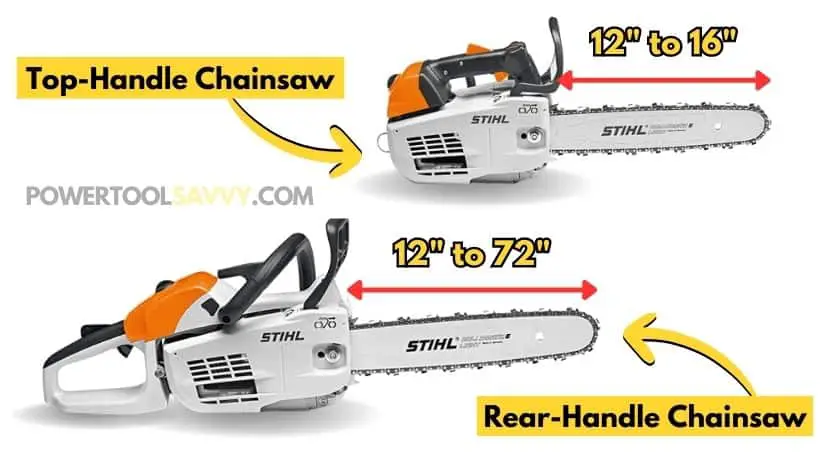
And frankly speaking, I don’t see the point of using a bar on top-handle saws.
Why??
First of all, they’re meant to be used for limbing and cutting branches, not felling trees or cutting thick logs. So, a bar longer than 16″ would just be overkill!
(Just picture this – You’re up in a tree, perched on a branch, and trying to cut something with a monster 20-inch bar! That’s a recipe for disaster!)
And secondly, a longer bar would add more weight to the saw, which is just a no-no already.
Here’s a bar length to weight table to support my point: 👇
| Bar Length | Added Weight |
|---|---|
| 16" | 1-1.5 lbs |
| 18" | 2-2.5 lbs |
| 20" | 2.5-3 lbs |
| 24" | 3-3.5 lbs |
| 28" | 3-4 lbs |
| 32" | 3.5-5 lbs |
| 34" | 4-5.5 lbs |
Top Handle VS Rear Handle Chainsaw - The Amount of Leverage You Get
Rear-handle chainsaws give you more leverage than top-handle saws.
The handle is positioned at the back, closer to the engine, giving you a longer lever arm to grip and control the saw as you wish.
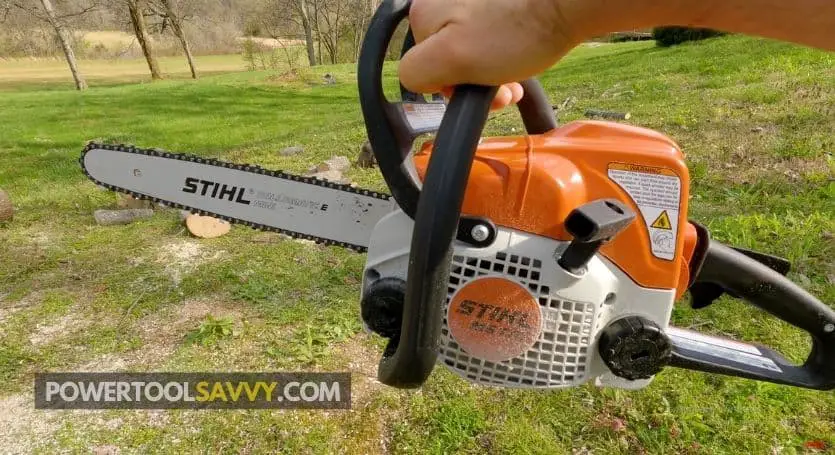
But on the other side, top-handle saws have a more compact design, with the handle located on the top, closer to the cutting bar.
While this design offers better maneuverability and allows climbers to work in tight spaces, it does sacrifice a bit of leverage!
(You just can’t play with the saw around like you would with a rear-handle model!)
That’s why I never use a top handle on the ground! (even though I’ve got a Stihl MS 201T and an ECHO CS-2511TES in my shed)
Are Top-Handle Chainsaws More Powerful?
In terms of power, there’s a BIG difference between top-handle and rear-handle saws!
Top-handle models usually range from 25cc to 40cc, while rear-handle models can go as high as 120cc
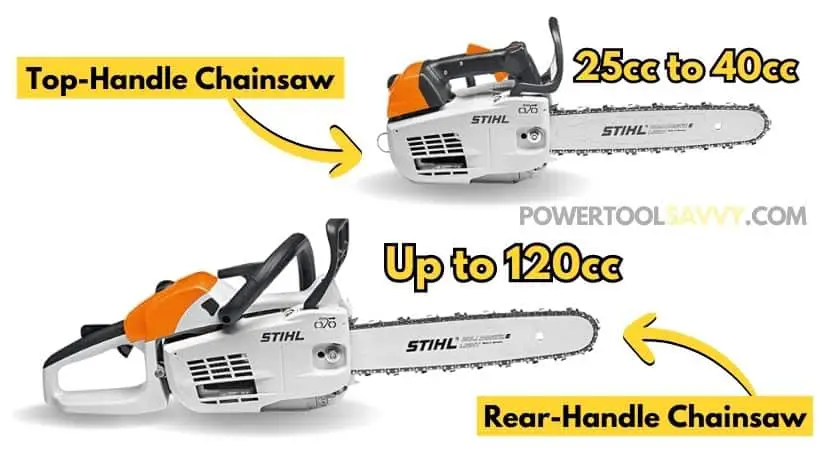
And speaking of battery-powered saws, top-handle models are usually between 18V to 40V, while rear-handle ones can range up to 80V.
So, in terms of sheer power, rear-handle chainsaws come out on TOP! (Plus, you get a wider range of saws to choose from!)
But don’t get me WRONG here!
I’m not saying that top-handle saws aren’t powerful enough.
It’s just that they’re meant to be as light and compact as possible. And that’s why, they can’t carry the same amount of power as their rear-handle buddies.
After all, you’re gonna climb up a tree with that thing!
(Press “F” to pay respects!)
Are Top-Handle Chainsaws Safer?
Let’s make it clear: 👇
“In the world of chainsaws, even the finest models can’t escape the possibility of accidents if they’re not wielded with CARE!“
Or in other words, it’s you who’s responsible for your own SAFETY! 🙂
(That’s why they boldly recommend wearing protective gear like gloves, chaps, helmets, hearing protection, and so on!)
Some of you might argue that top-handle saws are safer when it comes to working in trees.
While that’s kinda TRUE, the closely spaced design of the top-mounted handle often makes it easier to lose control.
(That’s one reason why these saws are not for beginners!)
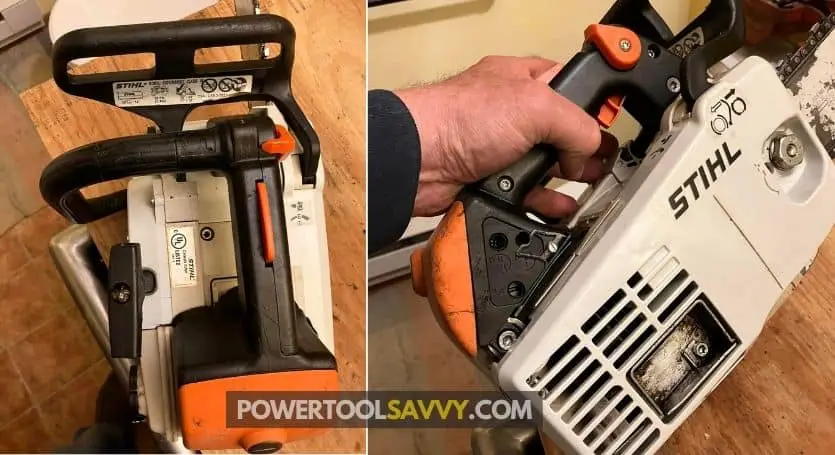
On top of it, when you have only one hand on the saw, it becomes a pivot point from an inertia standpoint, leaving you with limited control to withstand any sort of Kickback.
Plus, working at heights, unstable footing, and challenging angles make the situation even worse. (TRUST ME, I’ve been there!)
So, it’s not like that a top-handle saw is immune to all sorts of hazards. It’s still a powerful machine that requires caution, skill, and a healthy dose of common sense! 🧠
To me, top-handle saws are like a compromise made in recognition of the demanding working conditions climbers face and the occasional need to grip onto something else while cutting.
(Let me know your opinion in the comments below! 👇)
Are Top-Handle Chainsaws Beginner Friendly?
Last but not the least – Are top-handle chainsaws beginner friendly??
Top-handle saws are not beginner friendly at all. They’re designed for working in trees by professional arborists and tree surgeons only.
BIG brands like Husqvarna, Stihl, and Echo clearly mention in their user-manuals that – 👇
"These special (top-handle) chainsaws should be used only for work in a tree by persons who are trained in special cutting and working techniques and who are properly secured (lift bucket, ropes, safety harness)."
And if you want to get your hands on one, you need to get proper training first!
By training, I mean learning how to keep yourself safe and getting schooled in using all those fancy climbing gadgets (e.g. harnesses, ropes, belts, and snap hooks).
Not only that!
In some European countries, you’ll need to show off your certification of competence when buying a top-handle chainsaw, too!
On the flip side, rear-handle saws are much more beginner friendly. Just learn a few BASIC things like – 👇
- ✅ how to operate the saw safely,
- ✅ tensioning & sharpening the chain,
- ✅ some easy cutting techniques,
- ✅ how to maintain the saw,
and you’re GOOD to go!
No need to get a degree in Forestry here.

